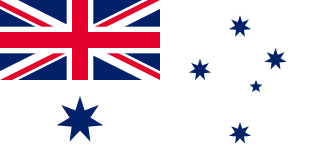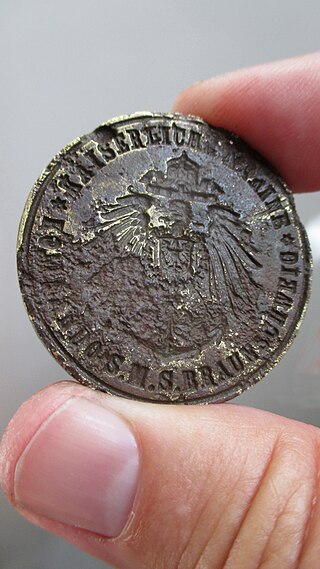Related Research Articles

The Royal Australian Navy (RAN) is the naval force of the Australian Defence Force (ADF). The professional head of the RAN is Chief of Navy (CN) Vice Admiral Mark Hammond AM, RAN. CN is also jointly responsible to the Minister of Defence (MINDEF) and the Chief of Defence Force (CDF). The Department of Defence as part of the Australian Public Service administers the ADF.
Rear admiral is a senior naval flag officer rank, equivalent to a major general and air vice marshal and above that of a commodore and captain, but below that of a vice admiral.

An ensign is the national flag flown on a vessel to indicate nationality. The ensign is the largest flag, generally flown at the stern (rear) of the ship while in port. The naval ensign, used on warships, may be different from the civil ensign or the yacht ensign. Large versions of naval ensigns called battle ensigns are used when a warship goes into battle. The ensign differs from the jack, which is flown from a jackstaff at the bow of a vessel.

A corvette is a small warship. It is traditionally the smallest class of vessel considered to be a proper warship. The warship class above the corvette is that of the frigate, while the class below was historically that of the sloop-of-war.
Second lieutenant is a junior commissioned officer military rank in many armed forces.
Commander is a common naval officer rank as well as a job title or "billet" in many armies. Commander is also used as a rank or title in other formal organizations, including several police forces. In several countries this naval rank is termed frigate captain.

HisMajesty's Ship, abbreviated HMS and H.M.S., is the ship prefix used for ships of the navy in some monarchies. Derived terms such as HMAS and equivalents in other languages such as SMS are used.

The Clearance Diving Branch is the specialist diving unit of the Royal Australian Navy (RAN) whose versatile role covers all spheres of military diving, and includes explosive ordnance disposal and maritime counter-terrorism. The Branch has evolved from traditional maritime diving, and explosive ordnance disposal, to include a special operations focus.

HMAS Australia was one of three Indefatigable-class battlecruisers built for the defence of the British Empire. Ordered by the Australian government in 1909, she was launched in 1911, and commissioned as flagship of the fledgling Royal Australian Navy (RAN) in 1913. Australia was the only capital ship ever to serve in the RAN.
Warrant Officer of the Navy (WO-N) is the most senior sailor in the Royal Australian Navy (RAN). It is a singular appointment, being only held by one person at any time. The special insignia for the WO-N is the Australian coat of arms with a wreath around it. The current Warrant Officer of the Navy is Andrew Bertoncin.

The Royal Australian Naval College (RANC), commonly known as HMAS Creswell, is the naval academy of the Royal Australian Navy (RAN). It consists of the RAN School of Survivability and Ship's Safety, Kalkara Flight, the Beecroft Weapons Range and an administrative support department. It is located between Jervis Bay Village and Greenpatch on the shores of Jervis Bay in the Jervis Bay Territory. Since 1915, the RANC has been the initial officer training establishment of the Royal Australian Navy.

The Australia Station was the British, and later Australian, naval command responsible for the waters around the Australian continent. Australia Station was under the command of the Commander-in-Chief, Australia Station, whose rank varied over time.

723 Squadron is a Royal Australian Navy Fleet Air Arm squadron. The squadron was first raised in 1952 and throughout its history has served operationally during the Vietnam War, the Gulf War and in East Timor. It currently operates as a helicopter training squadron and is based at HMAS Albatross at Nowra, New South Wales.
The Royal Australian Navy School of Underwater Medicine (RANSUM) is an instructor-led training course based at Sydney, Australia.
Fleet Command is responsible for the command, operations, readiness, training and force generation of all ships, submarines, aircraft squadrons, diving teams, and shore establishments of the Royal Australian Navy. Fleet Command is headquartered at HMAS Kuttabul in Sydney, and is led by the Commander Australian Fleet (COMAUSFLT), also referred to as Fleet Commander Australia (FCAUST), which is a rear admiral (two-star) appointment.

Ships and units of the Royal Australian Navy have received numerous battle honours throughout the navy's history.
The Navy Headquarters is the command responsible for training, personnel, resources, engineering and capability development of the Royal Australian Navy. As such Navy Headquarters works with the Capability Acquisition and Sustainment Group, the Defence Science and Technology Group, and the Joint Capabilities Group to ensure the personal, materiel and logistical capabilities of the Royal Australian Navy.
The following index is provided as an overview of and topical guide to Wikipedia's articles on recreational dive sites. The level of coverage may vary:

Recreational dive sites are specific places that recreational scuba divers go to enjoy the underwater environment or for training purposes. They include technical diving sites beyond the range generally accepted for recreational diving. In this context all diving done for recreational purposes is included. Professional diving tends to be done where the job is, and with the exception of diver training and leading groups of recreational divers, does not generally occur at specific sites chosen for their easy access, pleasant conditions or interesting features.
References
- Stevens, D. (2001). The Royal Australian Navy — A History. Melbourne: Oxford University Press. ISBN 0195555422.